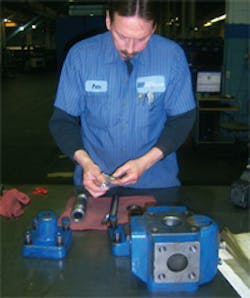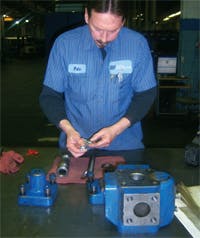Everyone knows the old adage, “If it ain’t broke, don’t fix it.” But what happens when it is broke? How does business — production, design, and manufacturing — continue, when machinery or one of its critical components, breaks? We live in a time when to just toss something into the trash is costly and not environmentally friendly, so it’s no surprise that most manufacturers and machinery operators turn to remanufacturing to get their machines up and running again. Not only do remanufactured components run just as well as new, they help eliminate downtime quicker than buying a new component, they cost less, and are a more green option.
Brian Berry, of Engineering Technology Services (ETS), says the choices are endless. “There are close to 3000 hydraulic repair/service companies in the USA,” Berry says. “They repair anything from hydraulic cylinders, pumps, and motors, to servo and proportional valves, and they replace hydraulic hoses and more. However, the ever-increasing question is: Which of these companies and what specific skills do they offer that best suit a company’s needs?”
The answer is that it’s a matter of finding someone you trust, who will provide a component that’s just as good as new, as if buying straight from the manufacturer.
“With evolving industries and technologies, repairing and rebuilding has become very common. Repaired, rebuilt components must function to their near originality,” says P.K. Guha, of Attica Hydraulic Exchange. “The repair units not only should look like new, but must also perform like the new relevant one. Therefore, the aesthetic and engineering aspects are both a significantly important formula for an efficient repair-rebuild process.”
There is no easy answer to the question of whether it’s better to buy new or have a component remanufactured, but factoring in time and money makes it easier.
A budget for repair
Most remanufacturers agree — if a customer can get a component repaired for less than a new one, it’s an easy decision for them to make. Although prices vary, most remanufacturers agree that buying a remanufactured component can be anywhere from 60 to 80% of the cost of buying new. Most also agree that when it comes to repairs, components such as hydrostatic transmissions, or those with electrohydraulic controls, are the most expensive to remanufacture due to their complexity, while cylinders are usually the least expensive.
Mel Maynard, manager of service business development for Bosch Rexroth Corp. says that most users will try to avoid buying new. “There are cost savings associated with a repair, but, potentially, greater savings with a remanufactured product. A repair usually requires a full tear down and failure analysis, with a report sent to the customer. Customers use this information as a guide for improving their maintenance and uptime for machines. Remanufactured units are essentially repaired products, utilizing a returned core of the same family and size. This core of re-usable parts is processed as any repair, but may not necessarily go back to the same customer.”
Remanufacturing obsolete components and machines is necessary for many manufacturers, who will definitely see a cost savings to having components rebuilt vs. buying a totally new machine for its processes.
Gary Hively, of Hydraulic Maintenance, says that with older equipment, repair is often faster than buying new. “Especially in older industrial machines, built in the 40s and 50s, buying a new machine or component is not an option,” Hively says. “We work on a lot of obsolete equipment.”
Joe S. Raccosta, of Hydraulic Parts Source, concurs, saying that especially with older equipment, remanufacturing can save a user between 50 and 70% compared to buying new components and machinery. “We can offer them huge savings,” Raccosta says. “In some cases, if a valve breaks, even if the cost-savings is only 20%, you’re still waiting for a new one, which costs you in downtime.”
Keep downtime to a minimum
When a component fails or breaks, the first thought may be to order a new part. But more often than not, ordering from the original manufacturer could mean a waiting time of weeks or even months. Most remanufactured parts are back to the end-user in just 24 hours, eliminating costly downtime.
Doug Hanson, president of Paddison Heavy Industries Ltd. and Hanson Hydraulics Ltd., says customers that can’t afford downtime will usually engage in an exchange program, so it’s a matter of removal and replacement, providing the least amount of down-time.
For example, Eaton Corp. keeps most remanufactured parts in stock for shipment within 24 hours, says Todd McIntyre of Eaton’s Re-Man Division. “Speed and delivery is always a very important aspect of any aftermarket product,” McIntyre says. “When a machine is down, you don’t always have to wait for a part. So availability and consistency of delivery is key.”
Wick Harwick, of Western Flui- Dyne, reiterates that time is more critical than money. “Remanufacturing houses typically have thousands of ‘cores’ in house. These cores are used pumps or motors, which have been partially torn down and are ready to be re-assembled to a customer’s exact needs. Typically, remanufacturing houses ship a replacement product the same day the order is received. Western FluiDyne ships 70% the same day and 90% by the next day.
“The customer returns its broken pump (for credit) at their leisure and often after the remanufactured pump has been received, installed, and in operation,” Harwick continues. “This rapid turnaround is one of the main drivers of the remanufacturing industry. The cost of machine downtime is almost always of greater concern than the cost of the individual components.”
Sometimes, users will pay more to avoid downtime. “The time to repair or reman is the deciding factor even when repair costs may exceed the cost of a new unit,” says Pat Callahan of Weber Hydraulics. “If a farmer has crops in the field or a city has a salt spreader that malfunctions in a blizzard, they cannot wait six to eight weeks for a new component.”
Finally, says ETS’ Berry, it’s best to provide the customer with as many options as possible. ETS offers spare parts, new or remanufactured, so the customer can repair their own unit; provides the option to send a unit in for repair and return it; and offers a service exchange unit in which ETS sends the customer a repaired unit, who in turn sends their unit to ETS as a core return.
Opting for a green alternative
Not only does remanufacturing save users money, it is also a green industry. Hydraulic Parts Source’s Raccosta says this is one area where the industry has been ahead of the game. “We are recycling the old units, salvaging cores, and when we’re done, they look like they’re brand new,” Raccosta says.
Bob Phillips, vice president of PSI Repair Services, says overall efficiency is an outcome that should not be taken lightly, highlighting that repairing a component vs. building one new reduces a company’s carbon footprint. “It not only saves money but helps reduce global pollution,” Phillips says.
Western FluiDyne’s Harwick agrees. “In a typical remanufacturing procedure, 60 to 85% of the parts, by weight, are reused. This is a tremendous savings in metal parts and housings that do not need to be reconstructed from new castings or bar stock. Even the broken or non-reusable parts are recycled into the scrap metals chain, where re-processors can turn these back into usable steel at a fraction of the energy costs of starting with iron ore or bauxite. Western Flui- Dyne typically returns 20 to 40 tons a month of scrap into the process.”
For tips on selecting a remanufacturing service, click here and an article on the history of the industry by P.K. Guha, click here.
|
Make Contact: • P.K. Guha, Attica Hydraulic Exchange, Chesterfield, Mich., (586) 949-4240, www.ahx1.com • Mel Maynard, Bosch Rexroth Corp., Service Business Development, Fountain Inn, S.C., (864) 237-1801, www.boschrexroth-us.com • Todd McIntyre, Eaton-ReMan Division, Eden Prairie, Minn., (952) 937-7288, www.eaton.com • Brian Berry, Engineering Technology Services, Memphis, Tenn., (901) 369-5404, www.etshydro.com • Doug Hanson, Hanson Hydraulics Ltd., and Paddison Heavy Industries Ltd., British Columbia, (250) 803-2124 • Gary Hively, Hydraulic Maintenance, Butler, Wis., (800) 236-8853, www.hydmaint.com • Joe S. Raccosta, Hydraulic Parts Source, Harrison Township, Mich., (586) 463-3166, www.hydparts.com • Bob Phillips, PSI Repair Services Inc., Livonia, Mich., (734) 853-5000, www.psirepair.com • Pat Callahan, Weber Hydraulics, Darien Center, N.Y., (585) 547-9931, www.callahanmc.com • Wick Harwick, Western FluiDyne, Fraser, Mich., (586) 296-7200, www.westernfluidyne.com |
About the Author

Leaders relevant to this article:


